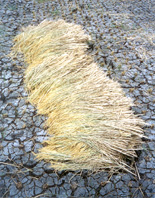![]() Species |
Rice |
Maize |
Wheat |
Barley |
Oats |
Foxtail Millet |
Pearl Millet |
Rye |
Sorghum |
Wild Rice |
Brachypodium |
Oryza Species |
Grape |
Arabidopsis
Species |
Rice |
Maize |
Wheat |
Barley |
Oats |
Foxtail Millet |
Pearl Millet |
Rye |
Sorghum |
Wild Rice |
Brachypodium |
Oryza Species |
Grape |
Arabidopsis
 |
 |
 |
 |
| Paddy with young rice Photo by Molly Fogleman | Young rice panicle Photo by Molly Fogleman | Mature rice panicle Photo by Molly Fogleman | Harvested rice on drained paddy Photo by Noel Yap |
Rice is central to the lives of billions of people around the world. Possibly the oldest domesticated grain (~10,000 years), rice is the staple food for 2.5 billion people (1) and growing rice is the largest single use of land for producing food, covering 9% of the earth's arable land. Rice provides 21% of global human per capita energy and 15% of per capital protein (2). Calories from rice are particularly important in Asia, especially among the poor, where it accounts for 50-80% of daily caloric intake (3). As expected, Asia accounts for over 90% of the world's production of rice, with China, India and Indonesia producing the most (4). Only 6-7% of the world's rice crop is traded in the world market. Thailand, Vietnam, China and the United States are the world's largest exporters. The United States produces 1.5% of the world's rice crop with Arkansas, California and Louisiana producing 80% of the U.S. rice crop (2).
85% of the rice that is produced in the world is used for direct human consumption (2). Rice can also be found in cereals, snack foods, brewed beverages, flour, oil, syrup and religious ceremonies to name a few other uses.
Rice belongs to the genus Oryza and has two cultivated and 22 wild species. The cultivated species are Oryza sativa and Oryza glaberrima. Oryza sativa is grown all over the world while Oryza glaberrima has been cultivated in West Africa for the last ~3500 years (3). Rice is grown under many different conditions and production systems, but submerged in water is the most common method used worldwide. Rice is the only cereal crop that can grow for long periods of time in standing water. (5). 57% of rice is grown on irrigated land, 25% on rainfed lowland, 10% on the uplands, 6% in deepwater, and 2% in tidal wetlands (6). The flooded rice paddy is a field of aquatic biodiversity, providing a home for fish, plants, amphibians, reptiles, mollusks, and crustaceans, which many of can be used as a means to incorporate protein into the diets of poor and malnourished people in low and middle income countries that farm rice (7).
Just as rice can be grown in many different environments, it has many characteristics, making one variety more popular in one region of the world than another. Rice can be a short, medium or long grain size. It can also be waxy (sticky) or non-waxy. Some rice varieties are considered aromatic (8, 9). Rice also comes in many different colors including brown, red, purple and black (10).
With that brief introduction to rice, we encourage you to explore Gramene's Doorway to Oryza to learn many more specific details about this versatile and very important grass species. If you are a breeder or researcher and are familiar with the general information of this page, please refer to Gramene Statistics and Queries for Oryza. These have been developed to make your time with Gramene more efficient.
References:
1. International Year of Rice, 2004. "Gender and rice" factsheet. [PDF] (Gramene Reference ID 8371)
2. International Rice Research Institute, 2002. Rice Almanac, 3rd Edition. (Gramene Reference ID 8379)
3. International Rice Research Institute, 2001. Rice Research and Production in the 21st Century. (Gramene Reference ID 8380)
4. International Rice Research Institute, RiceWeb.
5. International Year of Rice, 2004. "Rice and water: a long and diversified story" [PDF] factsheet. (Gramene Reference ID 8372)
6. Chopra, V.L. and S. Prakash, eds., 2002. Evolution and Adaptation of Cereal Crops. Science Publishers Inc, NH, USA. (Gramene Reference ID 8381)
7. International Year of Rice, 2004. "Aquatic biodiversity in rice fields" [PDF] factsheet. (Gramene Reference ID 8373)
8. Alford, J. and N. Duguid, 1998. Seductions of Rice. Artisan Publishers, NY, NY. (Gramene Reference ID 8382)
9. Chaudhary, R., et al., eds., 2001. Speciality rices of the world. Science Publishers, Inc, NH, USA. (Gramene Reference ID 8383)
10. International Year of Rice, 2004. "Rice and human nutrition" [PDF] factsheet. (Gramene Reference ID 8370)